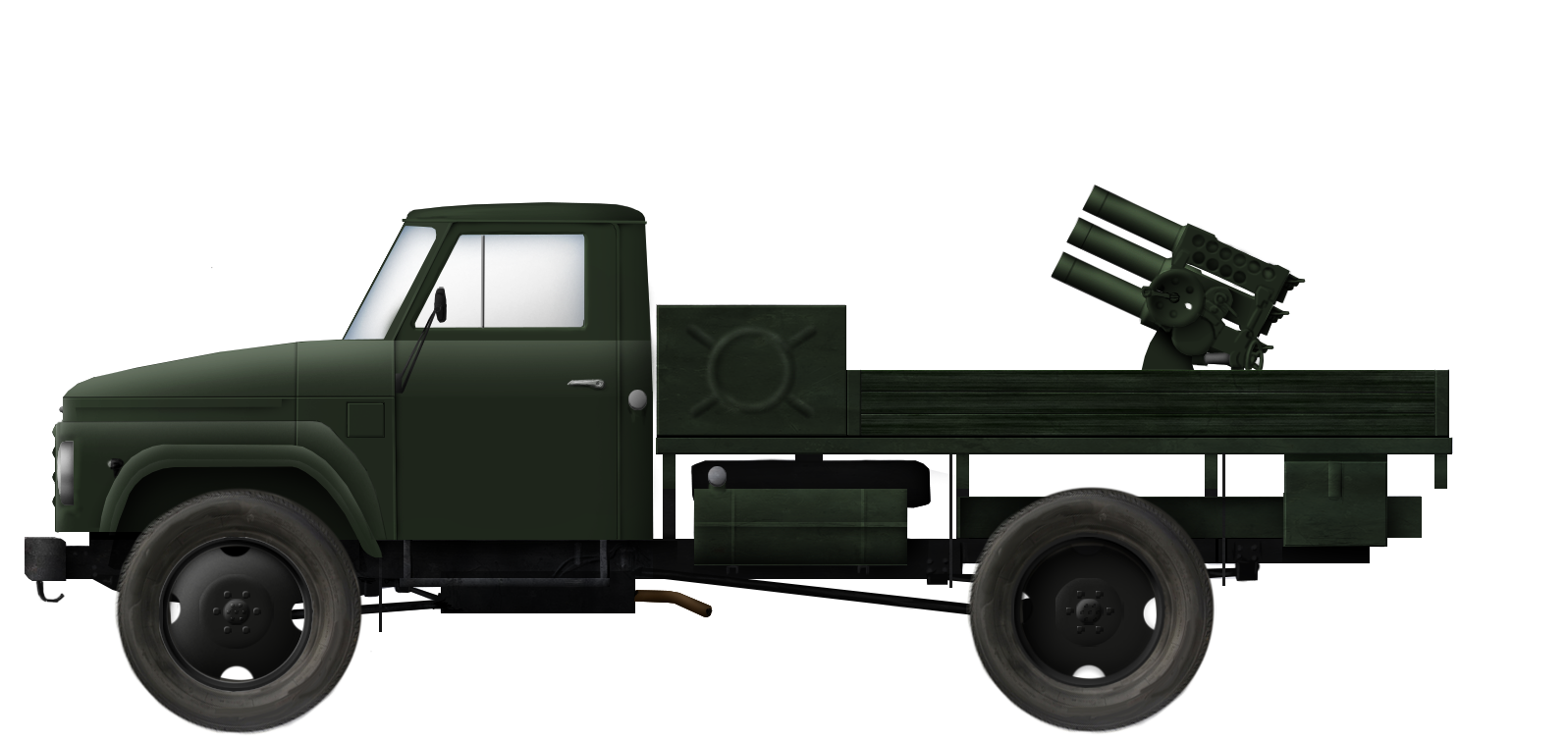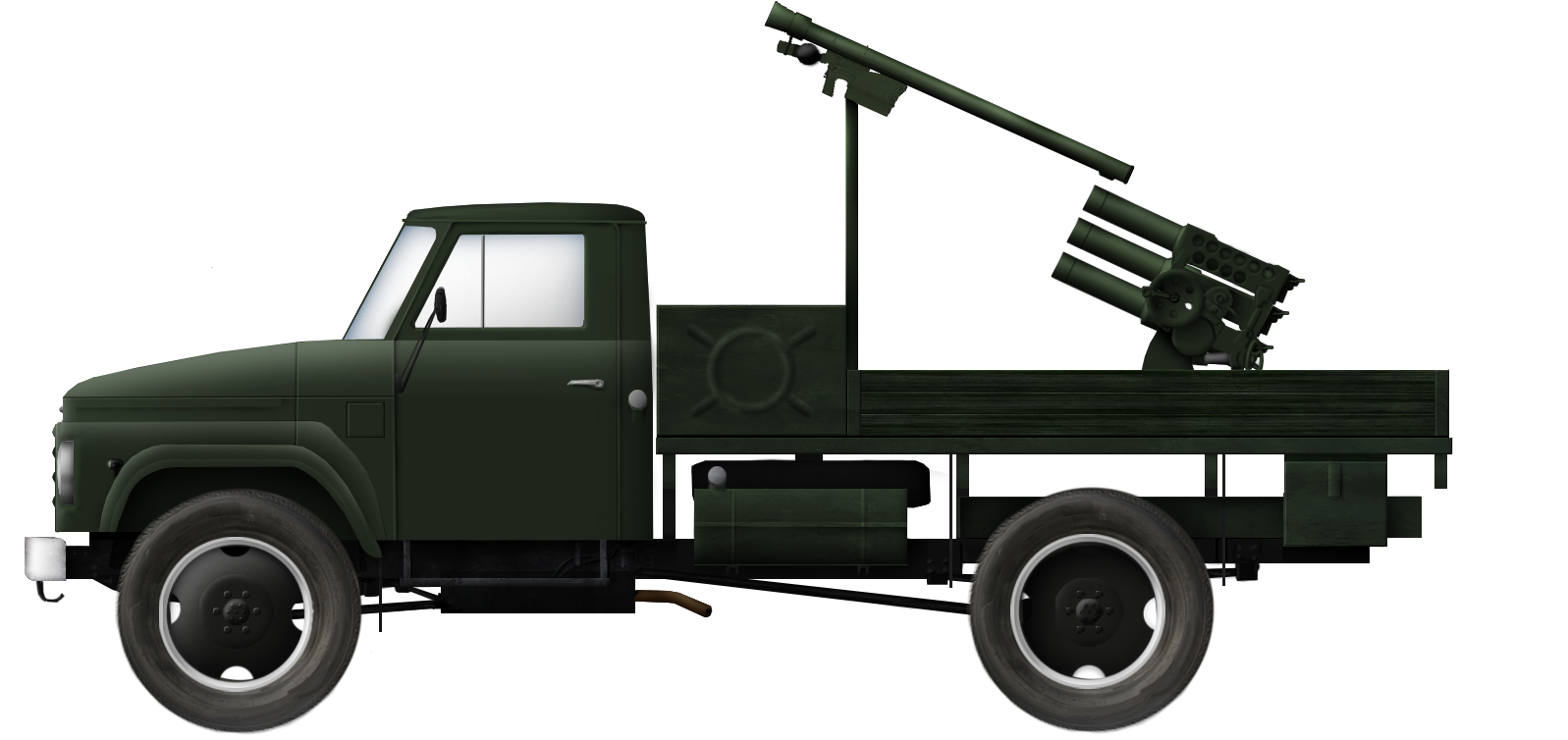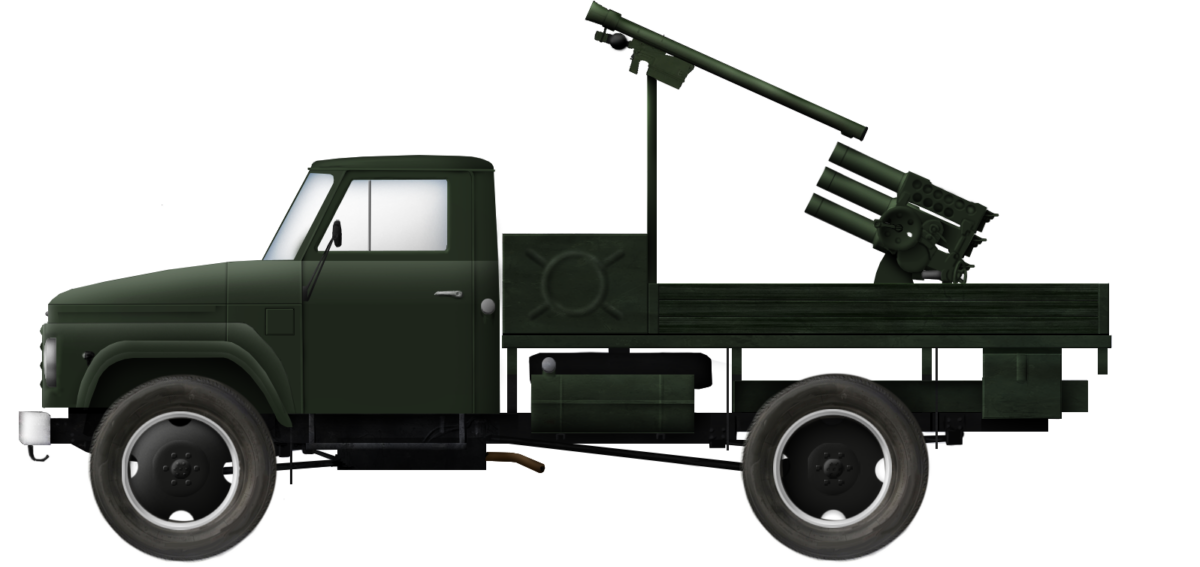 Democratic People’s Republic of Korea (1993-Present)
Democratic People’s Republic of Korea (1993-Present)
Multiple Rocket Launcher System (MRLS) – Unknown Number Produced
A major facet of the Korean People’s Army arsenal is the large quantity and variety of Multiple Rocket Launcher Systems (MLRS) it operates. Ever since the 1970s, and increasingly so in the next decades, a vast program was carried out to create a large and diverse fleet of vehicles. Starting from systems purchased from the Soviet Union and China, North Korea has increasingly introduced its own systems, some of which are actually mostly indigenous and somewhat competitive, notably the 240 mm systems first seen in the 1980s. In recent years, the even larger 300 mm KN-09, with seemingly very long-range, high accuracy, and large warheads, has been introduced.
However, these larger and longer-range systems sometimes obscure the large quantities of much simpler but still important systems. These provide the Korean People’s Army with the close-range firepower saturation it needs to hope to deliver large quantities of suppression to enemy forces. They are largely needed as North Korea is vastly unable to deliver suppressive firepower through other means considering the general obsolescence of the Korean People’s Army Air Force. Perhaps the most common light mobile Multiple Rocket Launcher System in service in the Korean People’s Army is the 107 mm Type 63 MLRS mounted on the Sungri-61NA truck, both of which are very common equipment of the KPA on their own.
The Sungri-61NA
The Sungri Motor Plant is a major automotive manufacturer within North Korea. It is based in the city of Tokchon, north of Pyongyang. Although founded in 1950, the factory would only begin producing vehicles in 1958. Until recently, when Pyeonghwa Motors superseded it, Sungri Motor Plant was the largest automotive manufacturer in the country. Nonetheless, the Sungri Motor Plant remains the largest truck manufacturer to this day. ‘Sungri’ means “Victory” in Korean.

The most common Sungri trucks are based on the Soviet GAZ-51 family of trucks. The GAZ-51 was a truck with an empty weight of 2.7 tonnes and with a load weight of 2.5 tonnes. The first Sungri truck, the Sungri-58, was a crude copy of the GAZ-51, which was overall very similar to the original 1946 GAZ-51, but was generally of lower production quality. Sungri-58 production would continue in the following decades and improved types would even be introduced in the 1970s, but the Sungri Motor Plant also began production of the Sungri-61 in 1961. This was a copy of the GAZ-63 truck, which was in itself merely a 4×4 version of the GAZ-51. Later, in 1971, the Sungri Motor Plants introduced a model with some significant modifications, the Sungri-61NA. It featured a redesigned cabin and engine hood, identifiable by the headlights being closer together and more integrated in the shape of the hood, as well as an increased payload.
The Sungri-61NA likely retains the same 6-cylinders engine as the GAZ-51. This is a GAZ-11 petrol engine, with a volume of 3,485 cm3, and a horsepower output of 70 hp at 2,800 rpm. It has a maximum torque of 201 Nm at 1,500 rpm. It ought to be noted that the engine is likely a North Korean copy, and quality issues are not entirely excluded. Some sources seem to claim the Sungri-61NA is a 4×2 truck, which seems odd, seeing as it is an evolution of the 4×4 Sungri-61. The payload is reported to be maintained at around 2.5 tonnes, despite opposing claims that the payload capacity was increased. Several different configurations have been seen. The truck exists both with rounded or square headlights, and can also feature either a doubled rear wheel, or a single wider rear wheel per side.
Overall, the Sungri trucks have been massively produced in North Korea, likely being the most produced trucks in the country.
The Type 63 107mm MRL
The Type 63 is a simple 107 mm rocket launcher that was designed and produced in the People’s Republic of China from the early 1960s. The standard launcher uses three rows of four launchers mounted on a split-trail carriage with two wheels fitted with pneumatics, which allows for considerable elevation of up to +57°.

The system has a limited maximum range of 8 km, and uses an 18.8 kg solid-fuel rocket with a fairly small warhead containing 1.3 kg of TNT. On the upside, it is an incredibly cheap platform that proved easy to produce in massive numbers, and could easily be operated in large numbers, be mounted on all kinds of platforms or even be carried around by infantry thanks to its lightweight.
With its cheap cost and non-negligible saturation potential, it is not surprising that the Type 63 proved to be a major success with the Korean People’s Army. Large-scale production of the type has been ongoing for decades, with the designation of “Type 75” sometimes being used for North Korean-produced 107 mm MRLs. The system has been widely used in various branches of the KPA. It has been in a frontline fire-support role since its introduction, but was also seen in coastal defense exercises, with its intended role presumably to target enemy forces as they land on a beach, and not naval assets.
The Truck-Borne MLRS
Seeing as the Sungri-61NA is the most commonly-produced North Korean light truck, and the 107 mm Type 63 an extremely common light multiple rocket launcher, it is not surprising that a combination of the two would eventually emerge. The 107 mm Type 63 is indeed widely mounted on North Korean vehicles. It has been spotted on non-turreted 323 armored personnel carriers – the “Sonyon” – as well as on other trucks.


The combination of the Sungri-61NA and Type 63 dates back to 1993 at the latest. This date also marked the beginning of one of North Korea’s periods of most hardship, often known as the “arduous march”, with the collapse of the Soviet Union causing a period of tremendous economic downturn and outright famine in the DPRK. The massive difficulties in acquiring materials and putting people to work led to a colossal reduction of productivity in this era, with only 150 trucks being produced by Sungri in its worst year, 1996. It appears many of these 150, and in general a significant proportion of Sungri-61NA trucks produced in this era, would be turned into MLRS vehicles. All Sungri-61NA used to create MLRS vehicles seen so far feature doubled rear wheels and rounded headlights.
The Sungri-61NA MLRS vehicles mount the 107 mm Type 63 to the rear of the vehicle. The open rear area of the vehicle features collapsable fenders. Thanks to the limited size of the Type 63 MLRS, it is actually far from completely occupying the rear bay of the Sungri-61NA. This free space was put to good use in the MLRS version. The space just behind the cabin was used to place ammunition boxes which presumably allow for the stowage of rockets for a second salvo after the first is fired.
The 107 mm Type 63 is able to fire an entire salvo in 7 to 9 seconds. Though its range, accuracy and explosive powers are fairly limited, it can reload quickly. The ability of a small truck mounting an MRL to stow one reload without relying on a secondary vehicle is quite impressive, and in theory, the ability of a Sungri-61NA battery to fire two salvoes of 107 mm rockets before promptly leaving to avoid counter-battery can be quite valuable militarily.

The photos we have of Sungri-61NA MRLS on parades appear to show a crew of six. Two crew members are in the cabin and four in the rear area, alongside the MRL. Considering the Type 63 is typically operated with a crew of five, though operation remains possible with a crew of four, it is likely the passenger of the cabin exits it to help with the firing and reloading. The vehicle’s crew can likely be divided into a driver, a commander, and four rocket launcher operators. Sometimes, only two crew members are present at the rear instead.
The KPA’s Most Common MLRS ?
While the Sungri-61NA MLRS was introduced at an unfortunate time for the KPA, the type appears to, over the years, have been produced in large numbers. Considering it combines likely the cheapest truck and MRL in North Korea, it is not surprising that the Sungri-61NA may very well have become the most commonly used MLRS in service in North Korea, though this cannot be confirmed for certain. It appears the system is typically operated at a regimental level.


In recent years, there have been some significant upgrades and evolution in North Korean MLRS. While more modern types, notably the 300 mm KN-09, have been introduced, large upgrades have also been applied to older 240 or 122 mm systems, such as, notably, GPS-guided rockets. However, because of the simplicity and limited evolutionary potential of the 107 mm rockets, it is likely that these upgrades appear to have largely not been implemented on the Sungri-61NA MLRS.
Nevertheless, one modification has been spotted in recent years, but does not concern the rocket-launcher itself. In recent parades, Sungri-61NA MLRS trucks were seen with two added Igla MANPADS (Man-portable air-defense system), one on each side of the rear area, located behind the ammunition boxes. Such an addition is not surprising, as fitting Iglas to all kinds of vehicles is a very common practice in the KPA. Though one may question the reasoning in fitting such missiles on an artillery vehicle, considering their potential is very limited against anything but helicopters and low-flying planes, an argument could be made that the limited range of 107 mm rockets would mean the vehicles would be quite close to the frontline and may end up confronted with an enemy helicopter. Still, mounting not one but two missiles appears a questionable decision. A more reasonable explanation for it is that mounting MANPADS on vehicles in parades does not appear to systematically equal these MANPADS being mounted in the field. There has indeed been a lot of footage of North Korean vehicles typically equipped with MANPADS in parades not featuring any during more operational exercises.
Conclusion – An Unsung Workhorse
When it comes to the Korean People’s Army, many of the more peculiar, quirky, and impressive designs created by North Korean engineers tend to attract major public attention. These may be the Songun-Ho or recent M2020, overshadowing the workhorses that are the older Chonma-Ho tanks and 323 APCs when it comes to armored fighting vehicles, and the 300 mm KN-09 or 240 mm systems such as the M1985 or M1991 eclipsing the very numerous 122 and 107 mm systems of the KPA. Though a variety of 107 mm-armed platforms exist, the Sungri-61NA is very likely the most commonly-used one. As such, it is a very important part of the lower echelons of North Korean rocket artillery. By itself, it may appear, and indeed is, an unimpressive system, merely being a 1960s MRL mounted on a truck-based on 1940s technology. But while it is certain Sungri-61NA MRLS would be destroyed in the dozens as soon as a conflict involving North and South Korea ignites, the large quantity of vehicles of the type in service is an important part of the overwhelming barrage of artillery that comprises perhaps the greatest threat posed by North Korea outside of nuclear warheads.


| 107 mm MRL on Sungri-61NA Specifications | |
|---|---|
| Length | Around 5.7 m |
| Width | Around 2.3 m |
| Engine | Likely GAZ-11 6-cylinders petrol engine producing 70 hp at 2,800 rpm |
| Maximum speed | Around 70 km/h maximum, perhaps less |
| Crew | One driver, one commander, 2 to 4 servants |
| Armament | 107 mm Type 63 MRL |
| Ammunition stowage | Likely 2 salvos |
| Armor protection | None |
Sources
THE ARMED FORCES OF NORTH KOREA, On The Path Of Songun, Stijn Mitzer, Joost Oliemans
Oryx Blog – North Korean vehicles: https://web.archive.org/web/20180713025455/http://spioenkop.blogspot.com/2014/01/north-korea-and-her-fighting-vehicles.html
https://mexanizm.livejournal.com/104494.html
https://www.chinesecars.net/content/sungri-61na-square-headlights-4×2

